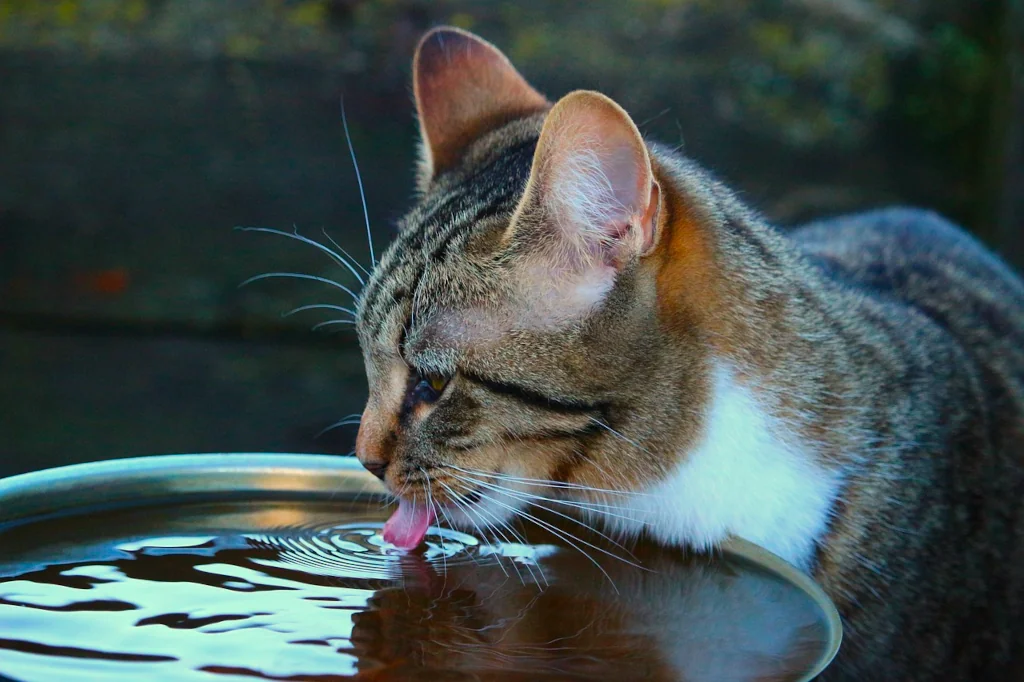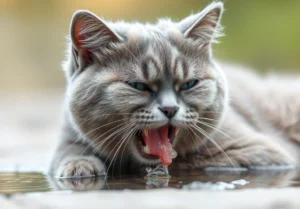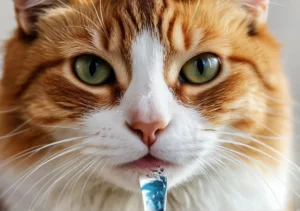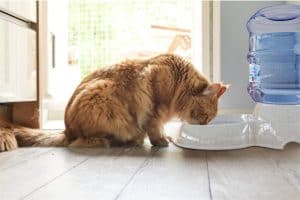Disclosure: We may earn a commission from helpful, relevant links in our content. No cost to you. See our privacy policy.
A cat’s purr is as much a joy as it is a mystery, isn’t it? At times it’s a lullaby of contentment, at others, a subtle plea for help, especially when it comes to their hydration.
As cat owners, we sometimes grapple with questions like – ‘Is my cat drinking enough water?’ or ‘Why won’t they drink from their bowl?’ They seem simple, yet the answers can be complex and nuanced.
In this blog post, we bridge that gap, providing practical insights on feline hydration – what it means, why it matters, and how you can ensure it. Rest assured, by the end, you’ll feel more confident in providing the care your feline friend needs, one lap of water at a time.

Why Hydration Is Crucial for Cats
A cat’s body, like ours, consists mostly of water – about 60 to 70%, to be precise.
This high water content supports crucial bodily functions such as digestion, absorption of nutrients, temperature regulation, and even the flushing out of toxins.
When a cat is well-hydrated, these functions are at their peak, ensuring your feline companion feels sprightly and stays healthy. Dehydration, on the other hand, can lead to an array of health issues, from urinary tract infections to kidney disease.
It’s clear then – keeping your cat hydrated is non-negotiable, and fortunately, it’s simpler than you might think.
How Often Should You Hydrate Your Cat?
A general guideline is that a cat should drink about 3.5 to 4.5 ounces of water per 5 pounds of body weight daily. That means, if you have a 10-pound cat, they should ideally be consuming about a cup of water each day.
However, the ideal water intake for a cat can vary based on factors such as age, size, diet, and even weather.
Remember, if your cat’s diet mostly consists of wet food, their required water intake will be on the lower end of the range, as wet food can contribute up to 80% water.
Nonetheless, always ensure fresh water is available for your cat throughout the day. Hydration needs can fluctuate, and it’s essential they have access to water whenever they need it.
Signs Your Cat Is Well-Hydrated
Recognizing a well-hydrated cat doesn’t require a veterinary degree, just some keen observation. Here are some key signs to look out for:
- Skin Elasticity. Gently pinch the skin at the back of your cat’s neck. If it snaps back quickly, that’s a sign of good hydration. If it slowly returns to place or remains tented, your cat may be dehydrated.
- Moist Gums. A well-hydrated cat’s gums should feel moist and slick to touch. Dry gums may indicate dehydration.
- Bright and Clear Eyes. Hydration contributes to maintaining healthy eyes. If your cat’s eyes are clear and bright, it’s likely they’re well-hydrated.
- Regular Urination. A hydrated cat should urinate at least once or twice a day. The urine should be light yellow or clear. Consult our guide on what to do if your cat is urinating often and outside the litter box.
Now, here’s a unique tip not commonly discussed: check your cat’s nose. While it’s a myth that a wet nose equals a healthy cat, extreme dryness or cracking could be a sign of dehydration. However, don’t rely solely on this, as some cats naturally have drier noses than others.

Why Do Some Cats Avoid Drinking From Bowls?
It may seem strange that your feline friend would avoid something as fundamental as a water bowl, but several reasons could explain this behavior:
Whisker Sensitivity. Cats have highly sensitive whiskers, and a narrow or deep bowl can cause ‘whisker stress’ or ‘whisker fatigue’ when they touch the sides of the bowl. If you suspect the bowl, then go for something like PetFusion Premium Stainless Steel Bowl. Its wide, shallow design accommodates sensitive whiskers, while the non-toxic stainless steel material guarantees a safe and fresh drinking source
Location. Cats often prefer their water source to be away from their food, possibly due to their instinctive behavior to avoid cross-contamination. If the water is right next to their food, they may avoid it.
Freshness of Water. Cats have a keen sense of taste and may avoid water that isn’t fresh. Changing the water regularly can help encourage drinking. Try to change your cat water once a day to keep it fresh and avoid bacterial contamination.
Type of Bowl. Some cats may prefer a specific material for their water bowls. Plastic can sometimes alter the taste of water, making ceramic or stainless steel bowls a better option. For ceramic lovers, the Ethical 5-Inch Stoneware Cat Dish offers a great blend of functionality and style. Its sturdy design prevents tipping, and the natural ceramic material does not interfere with the water’s taste, promoting hydration.
A running water source can sometimes entice a cat to drink more. Consider investing in a cat water fountain that continuously circulates the water, keeping it fresh and oxygenated, and often more attractive to cats due to the movement and sound of running water.
How Long Can a House Cat Go Without Water?
Hydration is paramount for any living creature, and cats are no exception. While a hardy house cat might withstand a few days without water, it’s a situation that can quickly turn dire. A mere 15% drop in body water could lead to severe illness or even death.
However, several factors influence how long a cat can go without water. These include their overall health, age, breed, and the climate.
For instance, an older cat or a cat with health issues might dehydrate faster than a young, healthy cat. Similarly, cats living in hot, dry climates would need more water compared to those in cooler regions.
On average, an adult cat in ideal conditions could manage to survive for about three days without water. But remember, “surviving” is not the same as “thriving.” A cat in such a situation is likely to suffer health complications, and seeking immediate veterinary attention is critical.
Try to observe your cat’s behavior closely. If they’re consuming less water or showing signs of lethargy, hiding, or loss of appetite, it might be an early indicator of dehydration. Being aware of such subtle signs can help ensure your cat never has to endure the distress of dehydration.
Always keep a fresh and accessible source of water for your cat. Your furry friend may not need to drink as much as a dog, but regular water intake is a non-negotiable aspect of their overall well-being. Remember, prevention is better than cure when it comes to keeping your cat healthy and hydrated.
FAQs
Can I give my cat any liquids other than water for hydration?
While water is the best hydration source, you can occasionally offer your cat low-sodium broths or even specially designed cat milk. Always avoid giving your cat milk meant for human consumption as it can upset their digestive system.
Does wet food contribute to a cat’s hydration?
Absolutely, wet food can significantly contribute to your cat’s hydration levels as it typically contains about 70-80% water.
Are there signs of overhydration in cats?
Yes, overhydration in cats can lead to water intoxication, symptoms of which may include vomiting, lethargy, dilated pupils, and in severe cases, difficulty breathing.
What can cause a cat to drink more or less than usual?
Changes in a cat’s drinking habits can be due to various factors, including their diet, environmental temperature, activity levels, and health conditions such as diabetes or kidney disease. If you notice drastic changes, it’s advisable to consult your vet.
Alex, a passionate animal lover, has experience in training and understanding animal behavior. As a proud pet parent to two dogs and three cats, he founded AnimalReport.net to share insights from animal experts and expand his knowledge of the animal kingdom.




